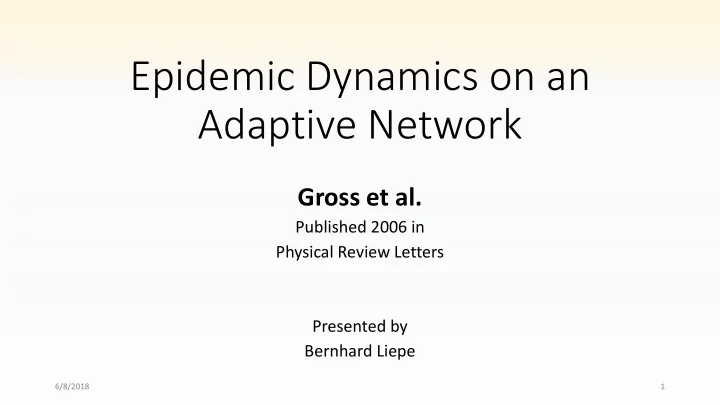

Epidemic Dynamics on an Adaptive Network Gross et al. Published 2006 in Physical Review Letters Presented by Bernhard Liepe 6/8/2018 1
Network topology has a strong impact on node dynamics https://de.wikipedia.org/wiki/Topologie_(Rechnernetz) 6/8/2018 2
Simple, but dynamic rules can generate a complex network topology • eg. Preferential attachment or selective rewiring • Shape real world networks like the internet http://guruprasad.net/posts/world-maps-data-patterns/ 6/8/2018 3
Susceptible-Infected-Susceptible (SIS) model on adaptive an network • Nodes can only be • Suceptible • Infected • Parameters • Number of nodes N • Bidirectional links Epidemic Rewiring K • Infection probability p • Recovery probability r • Rewiring w • Link to infected is cut with probability w a new link to other suceptible is formed 6/8/2018 4
High rewiring rate increases epidemic threshold • Epidemic threshold p* => Infection probability necessary to maintain stable infection level <k> = 2𝐿 𝑂 mean degree of nodes w - rewiring probability r – recovery probability 6/8/2018 5
Rewiring leads to seperated sup-populations and a dynamical equilibrium Mean degree of nearest-nieghbor Distribution of node degree Rewiring but Random rewiring Adaptive network no local dynamics 6/8/2018 6 (p = r = 0)
Adaptive SIS network leads to temporal fluctuations of degree of nodes • Susceptible degree shows linear increase in time • Infected degree decays exponentially -> dynamic equilibrium • Local effect of rewiring suppresses epidemic • Topology effect of rewiring promotes epidemic 6/8/2018 7
Dynamic model as a system of coupled differential equations Recovery of Infection of infected susceptibles SI to II link due II to SI link due to infection to recovery 6/8/2018 8
Hysteresis loops and discontinous transitions are generic features of the adaptive model • adaptive network with rewiring - ->Second threshold (saddle-node bifurcation) -> formation of hysteresis loop 6/8/2018 9
Two parameter bifurcation diagram summarizing model states • White and gray -> single attractor • Medium gray -> both stable • Dark grey -> stable healthy state coexists with epidemic cycle • Dash-dot -> transcritical bifurcation • Dashed -> saddle-node • Dotted -> cycle fold 6/8/2018 10
Thank you for you attention! Feel free to ask questions. 6/8/2018 11
Additional resources • https://de.wikipedia.org/wiki/Topologie_(Rechnernetz); 06.06.18 • http://guruprasad.net/posts/world-maps-data-patterns/; 06.06.18 6/8/2018 12
Recommend
More recommend